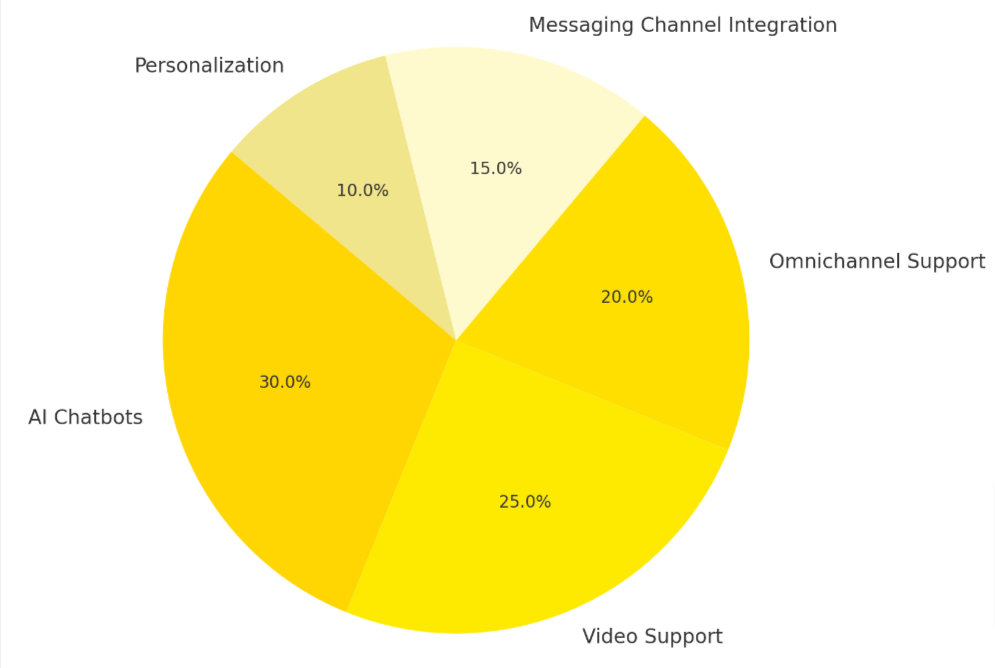Staying Ahead: Navigating New Trends in Live Chat Technology
You want to talk to someone fast when you have a question. Did you know live chat is the go-to way people get help these days? This post will show you the cool new things happening with live chats and what they mean for jobs.
Keep reading; it’s going to be interesting!
Key Takeaways
- AI chatbots are transforming customer service by handling routine questions, which frees up live chat agents to focus on more complex issues.
- Video support through live chat is becoming more common, allowing for face-to-face conversations and better issue resolution.
- The integration of messaging channels creates a consistent and efficient experience for customers across various platforms including email, social media, and phone calls.
- There’s an increasing investment in customer service technology leading to job growth in the tech industry for those skilled in managing digital communication tools.
- Continuous learning is essential for customer service professionals as they need to keep up with the latest trends such as omnichannel support and AI advancements.
The Growing Importance of Live Chat in Customer Service
Live chat has quickly become a game-changer in the realm of customer service innovation. Customers now expect real-time communication, craving instant answers and personalized support at their fingertips.
This shift towards digital messaging has put live chat in the spotlight as a vital tool for businesses that aim to stay competitive. Companies are adapting by integrating live chat capabilities into their online platforms, recognizing its power to boost satisfaction and loyalty among users.
With this advancement, seamless omnichannel support is no longer just an option but a necessity. Live chat allows customers to get help without interrupting their shopping experience, whether they need tech support or have questions about products.
It’s all about convenience – resolving issues quickly with minimal effort from the customer side. As preferences evolve and demand for online support grows, so does the relevance of having efficient live chat solutions in place for companies across industries.
Emerging Trends in Live Chat Technology
From AI chatbots to video support and omnichannel integration, live chat technology is constantly evolving to meet the needs of modern customer service. These emerging trends are shaping the future of online support and changing the way businesses interact with their customers.
Automation through AI chatbots
AI chatbots are reshaping how businesses handle customer inquiries. These virtual assistants communicate with customers in real-time, providing quick responses and self-service options.
Their advanced artificial intelligence allows them to learn from interactions, improving their ability to resolve issues without human help. Chatbots can handle a high volume of requests at once, making them a valuable asset for any online support system.
Incorporating chatbot technology into live chat services not only enhances the customer experience but also streamlines the work of tech support teams. Agents now focus on more complex tasks that require human empathy and decision-making skills.
As these digital messaging tools take over routine queries, they free up employees to tackle challenges that add greater value to the company and its services.
Omnichannel support
Omnichannel support takes customer service innovation to the next level by integrating various communication channels into a single, seamless experience. Whether it’s live chat, email, social media or phone calls, customers enjoy consistent and efficient help across all platforms.
This approach not only meets customer preferences for convenience but also increases chat resolution rates as representatives have access to previous interactions no matter which channel they come from.
Keeping up with digital messaging trends, omnichannel support employs predictive analytics to anticipate customer needs before they even reach out. Agents equipped with this knowledge can deliver faster and more personalized service.
As technology continues to evolve in the tech industry, the importance of agent training becomes ever more critical to maintain a high standard of online support that customers expect today.
Moving on from the reliance on traditional help desk systems, video support via live chat stands out as the next frontier in real-time communication.
Video support via live chat
Live chat technology is evolving to incorporate video support, allowing customers to engage in real-time face-to-face interactions with customer service representatives. This feature enhances the personalized nature of live chat interactions, fostering deeper connections and understanding between customers and agents.
Video support also enables visual demonstrations for technical support or product inquiries, enriching the customer experience and increasing first-contact resolution rates.
The integration of video support within live chat not only meets the growing demand for richer communication channels but also aligns with the preference for real-time engagement among customers, further enhancing the effectiveness of live chat as a key customer service innovation.
Personalization in live chat interactions
Live chat interactions are becoming more personalized, allowing businesses to tailor their support based on individual customer preferences. By leveraging predictive analytics and customer data, companies can offer tailored recommendations and responses in real-time, enhancing the overall customer experience.
This personalization not only leads to higher satisfaction rates but also strengthens brand loyalty and retention.
As technology continues to advance, it’s important for companies to stay ahead of the curve by integrating these personalization features into their live chat interactions, ultimately shaping the future of customer service.
Integration of messaging channels
Messaging channels such as live chat, email, and social media are now being integrated to create a seamless experience for customers. This integration allows agents to view and respond to customer messages from various platforms within the same interface.
By streamlining communication channels, businesses improve efficiency and provide better support to customers across different platforms.
Furthermore, integrating messaging channels enables companies to track customer interactions more effectively and maintain consistent communication regardless of the channel used. This not only enhances the overall customer experience but also helps in gaining insights into customer preferences and behavior, ultimately leading to improved service delivery.

The Impact on Employment
The impact on employment is significant, with an increase in investments in customer service and a focus on customer success leading to potential job growth in live chat-related roles.
There is also a growing need for continuous learning and development as new technologies and trends emerge in the industry.
Increase in investments in customer service
Companies are increasing investments in customer service to enhance the live chat experience for their customers. This includes deploying advanced tools and technologies, such as AI chatbots, omnichannel support, video assistance, and personalized interactions.
The goal is to provide seamless and efficient solutions that cater to evolving customer needs and preferences.
Amidst this investment surge, there’s a growing emphasis on leveraging data analytics and predictive insights to optimize chat resolution rates and deliver proactive support. As companies prioritize customer-centric strategies, the focus on agent training and continuous learning becomes paramount to ensure exceptional service delivery across digital messaging channels.
Focus on customer success
With the increase in investments in customer service, companies are placing a strong emphasis on customer success. This entails ensuring that customers achieve their desired outcomes while using the product or service.
By prioritizing customer success, businesses can drive satisfaction and loyalty, leading to long-term relationships with their client base. Utilizing emerging live chat technology and omnichannel support allows for proactive communication with customers, addressing their needs and concerns in real-time.
With personalized interactions and the integration of messaging channels, companies can deliver exceptional customer experiences, ultimately contributing to customer success.
Furthermore, leveraging predictive analytics in live chat interactions enables businesses to anticipate and meet customer preferences effectively. Through this approach, companies can enhance chat resolution rates and provide efficient support through self-service options tailored to individual requirements.
Need for continuous learning
Continuous learning is crucial in the fast-evolving landscape of live chat technology. As new features and tools are introduced, customer service professionals need to adapt and upskill to meet the changing demands of consumers.
Keeping abreast of emerging trends such as AI chatbots, omnichannel support, and video capabilities is vital for staying competitive in the industry. Ongoing education ensures that employees can effectively leverage these advancements to deliver exceptional customer experiences, ultimately contributing to business success.
To remain at the forefront of this dynamic field, professionals must engage in regular training programs focused on technical expertise, communication skills, and customer-centric strategies.
Potential for job growth in live chat-related roles
Chat technology is driving demand for new job roles, including live chat agents and specialists. Businesses are increasingly investing in customer service and support, creating opportunities for individuals with expertise in omnichannel support, real-time communication, and digital messaging platforms.
As the tech industry continues to evolve, there is an increasing need for professionals who can harness predictive analytics and artificial intelligence to improve chat resolution rates while delivering exceptional customer experiences.
The rise of AI chatbots is also reshaping employment trends by requiring agent training focused on managing these virtual assistants effectively. With the growing focus on personalized customer interactions, companies are seeking individuals who can adapt and thrive within this dynamic field.
Conclusion
As live chat technology continues to advance, businesses are reaping the benefits of improved customer service and efficiency. With the rise of AI chatbots, omnichannel support, and video capabilities, companies are better equipped to meet customer needs in real time.
These developments not only enhance customer experience but also impact employment trends by creating new opportunities for job growth and requiring continuous learning for those in live chat-related roles.
As the tech industry evolves, the integration of emerging live chat trends will undoubtedly shape the future of customer service and employment prospects.

